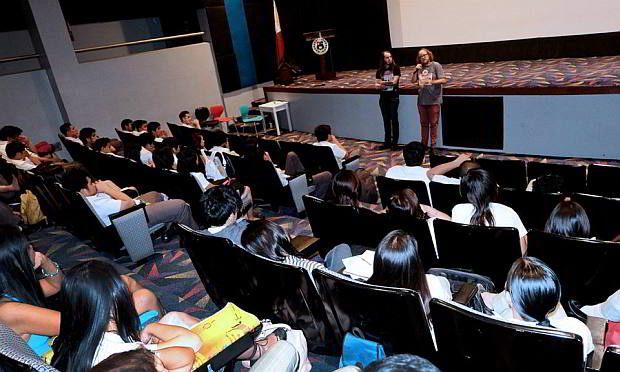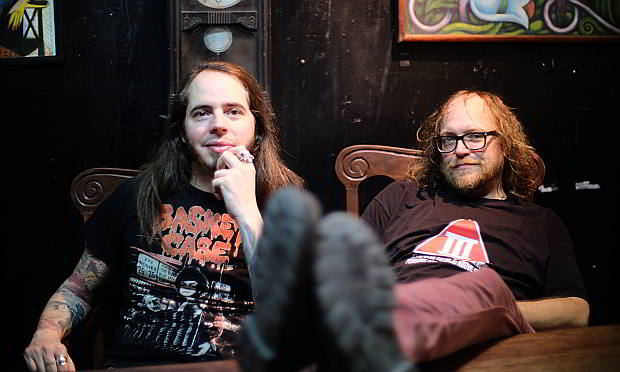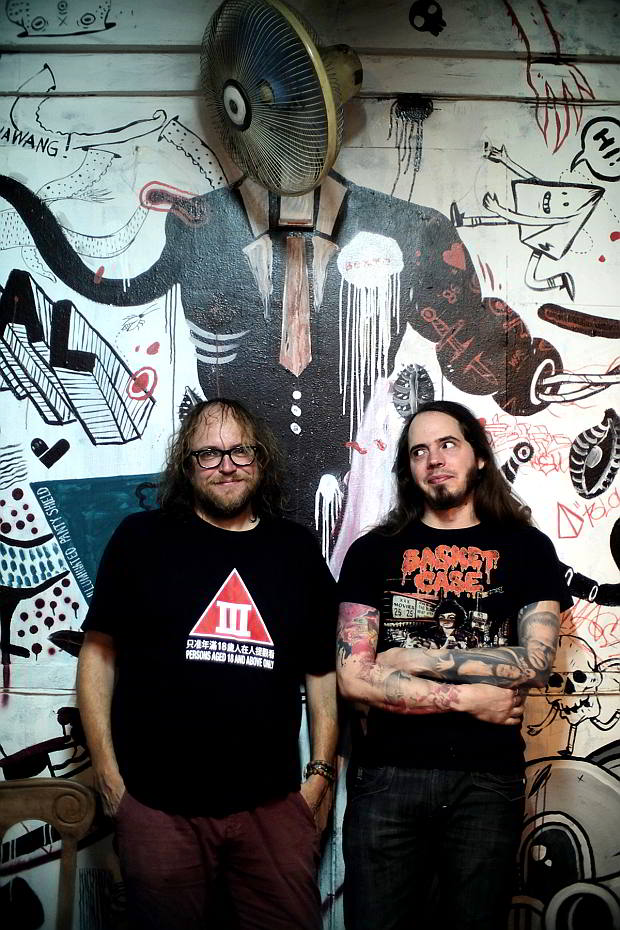Let’s get on the physical first, a Walter Becker-ish forehead and eyeglasses on Andrew Leavold and a Donald Fagen-like sullen demeanor on Daniel Palisa, these Aussie cinephiles easily bring to mind the jazz rock group Steely Dan. After a blink, their appearance would start evoking contemporary cinema’s zany pairs like the “Wayne’s World” duo Wayne and Garth, Jay and Silent Bob, or Bill and Ted.
And then Leavold begins to talk, and you realize that they, indeed, are the academe’s version of these wacky pairs.
On the sociological aspect, self-described guerilla filmmakers Leavold and Palisa are connoisseurs of the curious who after prowling sky high stacks of VHS for strange inspirations were blown away by a movie featuring the Philippines’ two-feet-nine-inch James Bond—Weng Weng. They began to ask questions. Who is this Weng Weng? What socio-cultural milieu could produce him? With questions such as these began their 20- year obsession which plunged them into the world of Philippine Martial Law era B-movie industry.
On a spiritual perspective, they are modern troubadours, digital journeymen whose goal is to go deep into the heart of man. They chose to enter it via the Philippine movie route with Weng Weng as their totem, their guide, their Virgil, or even Charon. In their seven-year-produced movie “The Search for Weng Weng,” they managed to capture a nation’s labyrinth of mayhem, corruption, betrayal, hope, dreams and resilience and there they found Imelda, the Sto. Niño and, in a way, themselves.
Read on as Leavold and Palisa weave the rest of the yarn.
When did the idea of doing a Weng Weng documentary occur to you?
Daniel: Well, I came in months after he talked it out with me.
Andrew: It was actually at some point in the 90s. I dreamt I was in a Manila hotel room with a camera on my left hand, a phone on the other, and I was telling someone, “My name is Andrew Leavold. I’m a filmmaker from Australia and I am here in Manila doing a film about Weng Weng!” Then I woke up, and I thought… what a great idea for a movie! And it was only in 2006 when I was invited to CineManila to talk about Filipino B-films that I thought of bringing a camera and start digging on Weng Weng’s story—to actually find him. I didn’t know at that point if he was alive or not. So there. In 2006, I said the same words, “My name is Andrew Leavold, I’m a filmmaker from Australia and I am here in Manila doing a film about Weng Weng!” And I was like, “Oh, my God! I actually dreamt this.”
How did you end up doing this together?
Daniel: Brisbane is very small, and we knew each other. He has this little videoshop, there was a point when we worked together during Brisbane International Film Festival Andrew worked on his program of strangeness. Hahaha. And I got to do my thing of strangeness. That was 2007, and we discussed it. It was then, over a drunken karaoke, when he said we should go to Manila and do this. The next morning, I showed up at the shop and Andrew with a hangover, slumped over the counter and slapped the plane ticket to me. Guess I am coming to Manila.
Andrew: So, your fate was sealed from that moment. Hahaha!
How did you get into filmmaking?
Andrew: I studied film at a university before having my own video store in the late 80s. A year after graduating, I was in public service working for welfare office, but the whole time, I kept dreaming about this video store with my favorite films all in their right order. I just wanted a place where film obsessed students can go to and rent out whatever they want. It was also at that time when I started to write my screenplay. It was almost a cliche of the video shop guy dreaming of being a filmmaker. I then started doing small-budget underground films in early 2000, basically training myself to shoot on the fly and be able to do low-budget guerilla shoots. It was at that point confident that I can go to the Philippines and be a one-man-crew and start shooting the documentary. Things just snowballed from there.
Daniel: I studied film as effects artist, doing makeup and prosthetics. Over the years, I’ve worked for it, because you really have to back yourself up and create a niche. I worked at the film festival already and they gave you programs with the writing side of film and film history. So when I met Andrew, that’s when I was knee deep into programming and focusing a lot on Asian cinema. So it was the best of both worlds—Asian cinema and exploitation cinema, and then came Filipino B-films, which was the next logical step to take.
What Filipino B-films made an impact on you?
Andrew: As a young cinephile, the ones that I saw were of Cirio Santiago’s “Mad Max” rip-offs like “Striker,” “Equalizer 2000,” and this other one for Roger Corman. It was sold on VHS in Australia, and without knowing it, I was amassing this collection of Filipino B-films. I even didn’t know that it was Filipino until I had those epiphanies. It was like, “God! Eddie Romero is Filipino!” I was watching “Black Mama White Mama,” “Mad Doctor of Blood Island”… these are Eddie Romero’s and they could have been made anywhere. So when I finally joined the dots together, it was like… the Philippines is where all the great B-films are coming from… it must be a productive industry that was producing these. And, of course, there’s this one film and one character that revolves around this… it’s “For Ur Height Only,” and it was then that I became consciously aware that it’s Filipino ‘cause there’s this portrait of Marcos in Intramuros and the Philippine Constabulary featured in the film. I was like, “Aha!
Filipinos must be about bad disco music, guys in Hawaiian shirts, and 70s porn mustache… everybody smoking, disco-dancing and beating the goons.” I was like, “This is where I wanna go!”
What motivated you to do this?
Andrew: Seeing this film—to me, it was like, this is a magical place. A film like that doesn’t just come out of the vacuum—it has to have that culture, and audience, and crew and funders. I thought I will decode this film and solve the mystery of Weng Weng— who he is and whatever happened to him after making those films, and whether he is still alive. That was the mystery. It brought me to Manila in 2006, and each time I had to borrow money from the store, until it eventually closed, and I had to borrow from other people so I could keep coming back here until we solved the mystery.

Daniel Palisa and Andrew Leavold talk about their film before film students of the University of San Carlos in Talamban. (CDN PHOTO/ GERARD PAREJA)
When did you decide that your work was already good enough as a film release?
Andrew: I think it was in the Imelda Marcos episode of the documentary that I thought we were so deep into the belly of the beast. It was at that moment—in that two-day journey into the heart of darkness, with Imelda that represents our journey to the Philippines, we’ve infiltrated the Philippines seated right across Imelda on her birthday party where we’ve recorded her talking about Weng Weng.
It was a defining moment in the film. Did you realize this when you made it?
Andrew: We thought that if we can only finish the film, its rights and all, that was it. Finally enough, we put a kickstarter event, together with $34,000 to complete the film… part of that money was to go to the final shoot. It was on that final shoot that we really had the finer personal details coming out. We get to do the second interview with the brother, we found Dante “Boy” Pangilinan, the director, more information from the Caballes family—all the relevant information.
After this project, what’s in the pipeline?
Andrew: Our company Death Rides a Red Horse has maybe seven ideas on the table.
Daniel: One of them is a kind of “Pinoy Expendables”—a violent action film with Bambi Beltran as an aging mercenary versus Visayan pirates.
How was the reception to your documentary when it was screened in Europe?
Andrew: I ended up spending 13 weeks in nine countries. We screened in all of them. Up in the north of Italy, there were about 300 in the audience, and it was all standing ovation. I saw the figures, and out of 65 films we came fifth. That’s just incredible. In the audience choice we came 10th out of the 65 films—just incredible. “Boy Golden” was also shown there, along with a Chito Roño film. All in all, we came fifth! People would come to us and say they never heard of stories like this coming from the Philippines, or they never considered the Philippines a filmmaking destination.
Daniel: The story of Weng Weng strikes a chord with universal viewers since it has a very human story at the heart of the film.
Andrew: Audiences here react differently to the film, as we are telling it with many layers suited for the local audience. I guess we are doing it in a respectful and in a compassionate way which is affecting particular people who have never given local cinema much of a chance. It presents the culture in a way you can be proud of. B-films can be very subversive, it’s taking on Hollywood and Europe.
What can you say about “maindie” or mainstreaming the indie film movement?
Andrew: I think there’s room for all films because cinema is not just a singular entity—it’s a multi-headed beast. I think there’s a room for Metro Manila films as it already has the audience. Indie films are for certain audience as well. If you merge the two, it would produce a certain kind of filmmaking, and there’s room for that one, too.
The real indie—the experimental kids are doing good in Rotterdam and Lav Diaz’s four-hour epic is now showing in cinemas. Internationally, “OTJ” (On The Job) is getting a DVD release in Australia.
“The Road” by Yam Laranas is getting a theatrical run in the US. It’s just amazing! This would not have happened in 2006 when we first came, and hearing the head of the film academy Espiridion Laxa saying that this kind of cinema is not just dying, but dead… What a glorious resurrection!
Who are your favorite Filipino filmmakers?
Daniel: We have the same!
Andrew: Celso Ad Castillo— he was really cracked, crazy genius. His films “Ang Pinakamagandang Hayop sa Balat ng Lupa,” “Burlesque Queen,” “Snake Sisters,” “Isla” and “Paradise Inn”—all of them are brilliant! Also, there’s Eddie Romero. And Bobby Suarez was king.
Elwood Perez and Joey Gosienfiao were the genre defining directors of the 70s!
Where are you off to after screening “The Search for Weng Weng” here in Cebu?
Daniel: We will go to Iloilo, then two screenings in Diliman, and we will be showing it in Weng Weng’s neighborhood, outside Weng Weng’s house. This is for the family, his relatives. So there will be food and booze… and more booze. More of like a little thanksgiving for these people in helping us out.
So everything started with Weng Weng?
Andrew: Everything is a journey with Weng Weng. I must have watched maybe a thousand films after that and probably a thousand more to go. I realize that it can’t end with Weng Weng. This is my second home and this is the culture that should be enriched. I will be teaching in a university and I will tell them about it. It’s a lifetime project for us. The Philippines is a journey. Everywhere else, you feel like a visitor, and here you’re home—you have extended families. You have Weng Weng’s family taking us in, Bobby Suarez’s family taking us in as well. We have maybe five or six families.
We’ve been adopted—that is the Filipino experience.
Daniel: Films are life changing. With all the experience making this, my life has changed. I have moved here, and will stay here.




